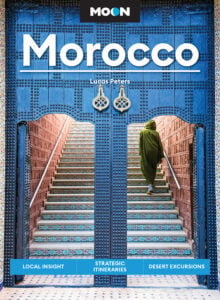
If you are heading to Tangier anytime soon, do yourself a huge favor and pick up Tangier: A Literary Guide for Travellers . Sometimes fantastic, often incredible, other times unbelievable – this deftly researched love-letter to one of the world’s most storied cities unearths the stories of the writers and artists who have called Tangier home or passed through here on adventures of their own. These stories are deftly woven together, creating a fabric of a place, one that you can carry with you on your travels.
Today, we’re talking with Josh Shoemake, the author responsible for Tangier: A Literary Guide for Travellers. Josh was born in Virginia and lived in Morocco for 13 years. He was a teacher at The American School of Tangier and then served as headmaster of The American School of Marrakesh. He’s published fiction and non-fiction. His excellent literary history of Tangier has been praised by The Sunday Times, The TLS, The Guardian, and others. He now lives in Paris.
JBT: Josh, Tangier: A Literary Guide for Travellers is incredibly rooted in place. The central thread of your book is obviously a writer or a piece of writing’s connection with Tangier as a place. During the course of your research, what was the writer or work you were most surprised to see pop up in their connection with Tangier. Or maybe the better question is what writer’s or writing’s connection with Tangier most surprised you and why?

Josh Shoemake: Most people are aware of the Beats in Tangier: Ginsberg, Kerouac, Burroughs, etc., all of whom were inspired to visit by Paul Bowles. But few realize how consistently literary Tangier has been throughout the centuries. This was also a discovery for me. Here’s just a partial list of writers who wander through the book:
Hans Christian Andersen, Samuel Beckett, Anthony Burgess, Truman Capote, Paolo Coelho, James Fenimore Cooper, Alexandre Dumas, Ian Fleming, Patricia Highsmith, Richard Hughes, Christopher Isherwood, Joseph Kessel, Joe Orton, George Orwell, Cynthia Ozick, Samuel Pepys, Susan Sontag, Paul Theroux, Mark Twain and Gore Vidal.
Hans Christian Andersen? Several of those were surprises.
JBT: Of the many writers that make an appearance in your book, do you have a favorite writer? Can you tell us a bit more about him or her, the link to Tangier and why this is your favorite writer?
JS: Paul Bowles. Whatever your opinion of him, in Tangier you have to reckon with him first. I happen to think he writes some of the most perfect sentences of the past hundred years, like those sharp knives that tend to appear in his stories, doing things more horrific than you, in your naivete, ever imagined a knife might do. Does he move me? No. But sentence to sentence, he’s rarely anything other than perfect.
But if you want someone to make you fall in love with whomever you set eyes on next, a beautiful catastrophe who will toss your heart aside like some plastic bag, leaving you alone on some rooftop as the chergui blows through the city, making everything seem as miserable as you – if that exquisite, awful feeling is what you’re after, then go to Alfred Chester, whom I only discovered while writing the book – a mostly forgotten darling of the intellectual New York Partisan Review crowd (Sontag, etc.) who moved to Tangier at the instigation of Bowles and put his whole heart into falling apart. He’ll make you want to fall apart too, and savor the misery. Until it’s all too much, and you go back to Bowles, having decided that burial up to one’s neck in desert sand is a better fate than falling in love.
JBT: In any book, scenes get cut and stories are left on editing floor. Did you have a particular story that you really enjoyed about Tangier that was left out in the final edition of the book?
JS: I’d like to think that the whole of Tangier’s literary history is crowded into this book. Everybody’s pushing past everybody else on the narrow medina streets. But every time I go to a party and start talking about the book, it seems, somebody will say: but what about so-and-so. Surely so-and-so is in there. But so-and-so is not. I have never heard of so-and-so. And so I go off and read this missed master so-and-so, who was (inevitably) drawn to Tangier, and then I long for my book to become Tangier, constantly re-becoming everything it’s always been, layer upon crumbling layer, all of them, fact and fiction, showing through into this moment right now as we’re walking down the street in 2018, or 2038, discovering Tangier again and again.
One I especially regret missing: Raymond Chandler, who apparently spent a night in 1955 alone with Natasha, the wife of his friend Stephen Spender – more research is required.
More concretely: While researching the book I mapped most every place of literary significance in Tangier. I would have liked a better map, but put one up here instead: www.joshshoemake.com/maps

JBT: One of the most striking things about Tangier: A Literary Guide for Travellers, isn’t just your historical knowledge of this great, vibrant city, but your physical knowledge of this place that is often confusing for most people. It really seems like you know all the little twists and turns in the old medina and your way around Jbel Kbeer. How did you first get to know Tangier this intimately?
JS: I arrived in Tangier right after college, aged 22. I had no idea what I was getting into, other than that I was meant to teach literature. Like many people who visit, immediately upon arrival I felt as if I’d become someone else. Maybe an exiled artist. Maybe a secret agent. Maybe the prodigal heir to vast fortunes. But of course I was none of these, and consequently felt more lost than ever. But I liked it – that was the thing. And the city itself seemed to hold the secrets to my multiplying questions, so I wandered and wandered, as if medina streets led into secret corners of my brain. And labyrinthine days led to long nights on starry beaches and gloriously grotesque bars. I was mapping it all out, mapping my possibilities as I mapped the city.
And I still get lost in the medina, which is the point if you’re doing it right.
JBT: Besides your book, do you have any other books you think we should read before we step foot in Tangier? Or maybe a book recommendation for someone who really, really loves Tangier and they might not have read yet?
JS: This book runs into most of the other essential Tangier books as it wanders along, but like a proper flaneur, it doesn’t play favorites. It just looks and moves on (to paraphrase the great Tangier novel by Mohamed Mrabet). But obviously I have those I especially love. The Times correspondent Walter Harris’s tale of his own adventures, The Morocco That Was, is an old standby for the turn of the twentieth century, with some hilarious scenes featuring dissolute sultans. For novels, I surely reveal my biases in the book, but the triumvirate is Bowles, Burroughs, and Mohamed Choukri. For Bowles, the Tangier novel is Let It Come Down: decadent expats, violent consequences. Burroughs is too much Burroughs to be linked to a place, even if his Interzone is extraterrestrial Tangier. Read Naked Lunch in small doses, like forged prescriptions for a disreputable Spanish methadone clinic. And then Choukri’s For Bread Alone is still the great modern Moroccan novel for now – brutal, clear-eyed, unpretentious. Those are my own biases, more traditionally novelistic than political. But most would agree that they’ve stood the test of time.
JBT: What are you doing these days? Are you working on another book?
JS: My mind’s still in Morocco. It’s in Casablanca and the year is 1951 and I’m hanging out with a fourteen-year-old girl named Touria Chaoui. She is about to become the first civil pilot in Moroccan history. Five years from now, in 1956, she will be shot by an unknown assassin on the eve of Moroccan independence. Her story is mostly forgotten, so I’m trying to understand why, and following her story where it leads – lost in another medina.
JBT: Josh, thank you for taking the time to talk with us. Good luck on your next story. We can’t wait to read it!
You can pick up Tangier: A Literary Guide for Travellers wherever you buy your books or in Tangier at the Librarie des Colonnes bookstore.
Find Josh Shoemake on Facebook, Twitter and his website: http://www.joshshoemake.com/.
About the Author
 Morocco expert, writer and photographer Lucas Peters curates and edits the Journey Beyond Travel blog and pens the JBT Insider’s Guide series. After spending years traveling to the distant corners of Morocco, he penned the best-selling guidebook Moon Morocco. He is now based in Paris, where he lives with his wife and son.
Morocco expert, writer and photographer Lucas Peters curates and edits the Journey Beyond Travel blog and pens the JBT Insider’s Guide series. After spending years traveling to the distant corners of Morocco, he penned the best-selling guidebook Moon Morocco. He is now based in Paris, where he lives with his wife and son.








